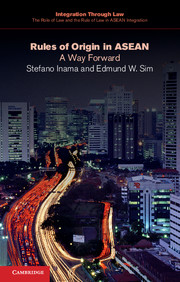Book contents
- Frontmatter
- Contents
- List of Tables
- General Editors’ preface
- Preface
- List of Abbreviations
- Chapter 1 Introduction
- Chapter 2 The initial set of ASEAN rules of origin: the lack of clarity and transparency masquerading as simplicity 1992–1995
- Chapter 3 Externalizing the confusion: the proliferation of rules in the ASEAN FTAs with dialogue partners
- Chapter 4 The silent cost: the cumbersome administration of ASEAN rules of origin
- Chapter 5 The possible way forward: self-certification
- Chapter 6 Conclusion and recommendations
- Executive Summary
- Appendices
- Bibliography
- Index
- References
Chapter 1 - Introduction
Published online by Cambridge University Press: 05 March 2015
- Frontmatter
- Contents
- List of Tables
- General Editors’ preface
- Preface
- List of Abbreviations
- Chapter 1 Introduction
- Chapter 2 The initial set of ASEAN rules of origin: the lack of clarity and transparency masquerading as simplicity 1992–1995
- Chapter 3 Externalizing the confusion: the proliferation of rules in the ASEAN FTAs with dialogue partners
- Chapter 4 The silent cost: the cumbersome administration of ASEAN rules of origin
- Chapter 5 The possible way forward: self-certification
- Chapter 6 Conclusion and recommendations
- Executive Summary
- Appendices
- Bibliography
- Index
- References
Summary
ASEAN Rules of Origin (RoOs) have often been branded as an example of simplicity, including by ASEAN's own leaders. However a number of reports and the increased calls by the same leaders to further simplify the ASEAN RoOs tell a different story.
In reality, the RoOs contained in the AFTA implementing the Common Effective Preferential Tariff (CEPT) Scheme have been systematically revisited for more than two decades by the ASEAN negotiating machinery in a perpetual quest to improve them. The results have been less than meager. Such failure is the result from, on the one hand, a consistent allergy to drawing from the lessons learned in ASEAN and in other regions, and, on the other hand, lack of capacity or simple inability to draft predictable and transparent legal texts on RoOs. All of this has been complicated by the “ASEAN Way” of consensus and non-confrontation; the “ASEAN Way” prevents problems from being raised or addressed.
In the face of its domestic failures, ASEAN has tried to export its model of RoOs when negotiating bilateral or plurilateral FTAs with, again, meager results. So far, the FTAs with China and India still reflect the shortcomings of the ASEAN RoOs, while the other FTAs negotiated by ASEAN with Japan, Korea and Australia/New Zealand reflect the RoOs models of these respective ASEAN partners.
- Type
- Chapter
- Information
- Rules of Origin in ASEANA Way Forward, pp. 1 - 11Publisher: Cambridge University PressPrint publication year: 2015



